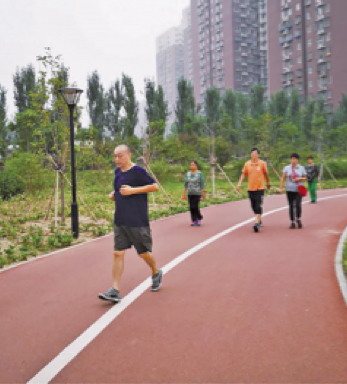Getting around in a smart and eco-friendly way
Chaoyang District has adopted ongoing measures to improve the quality of urban refined management, making traffic smoother, parking more convenient, and traffic smarter, so as to improve the travel experience of Chaoyang residents.
SMART TRANSPORTATION
Electronic billing and online payment for parking are available. Currently, the electronic ticketing facilities in Chaoyang District are mainly based on high-position camera monitoring, while parking at the side of some roads is temporarily paid based on low-position camera monitoring, earth inductor sensing and POS management. When a vehicle enters a parking space equipped with electronic billing facilities on the roadside, the high-position camera will automatically enter the vehicle information and parking order, without the operation of an on-site administrator. Online self-service payment for parking fees can be made through Alipay and WeChat. In addition, Chaoyang Parking Company has been established to manage electronic ticketing of all registered roadside parking spaces. At present, 11,000 roadside parking lots applicable to electronic billing are available to facilitate travel.


Street poles with integrated functions enable smart traffic. Traffic monitoring probes set at several intersections in the Beijing CBD area collect real-time traffic data to facilitate traffic analysis and guidance by relevant departments. The poles can carry 5G base stations, electric police equipment, environmental monitor, wireless WIFI, etc. The integrated pole is designed with a chute, which can be expanded according to practical needs and significantly reduce the occupation of road space.
Technology facilitates the development of public travel and green travel. Chaoyang District makes ongoing efforts to improve the traffic environment for pedestrians and non-motor vehicles, establishes a shared bicycle system and walking system that are safe, comfortable, and convenient. "Light Label" in the street of Guomao in CBD - AR indicators of slow traffic system – are developed by applying visible light communication and positioning of the light field, making people aware of real scenarios through virtual slow traffic system. For bicycle lanes, the original white isolation fences were replaced with "pavement markings" which effectively separate the traffic of motor vehicles and non-motor vehicles by vibrating any vehicle riding on them. They act as warnings for both drivers of vehicles and riders of bicycles.
LOW-CARBON TRANSPORTATION
In response to the "MaaS Travel, Green City" initiative, Chaoyang District fosters a new, comprehensive, targeted, and market-oriented model to encourage green travel, and achieved, for the first time in the country, all-green and low-carbon travel covering buses, subways, bicycles and walking.


The MaaS platform provides technical support for collecting information on citizens' green travel choices, provides an environment for refined calculation of carbon emission reduction, and makes it possible for individuals to participate in carbon trading through green travel. This measure effectively benefits both society and individuals, and can be replicated across the country.
In the future, Chaoyang residents may use AutoNavi Maps and Baidu Maps APPs for route planning and navigation while traveling by bus, subway, bicycle or walking, and collect carbon energy for the travel, which can be exchanged for different rewards. For example, 500kg of carbon energy can be exchanged for Beijing Municipal Administration & Communication Card (Yikatong) recharge code worth 100 yuan, and 900kg carbon energy for that worth 200 yuan. The carbon energy may also be exchanged for hotel discount coupons, VIP membership of online video platform, etc.
At the same time, Chaoyang District cooperates with Beijing municipal departments to promote the supervision and services of internet rental bicycles and regulates the total amount of shared bikes available to the public. The daily average number of bicycle trips in Chaoyang registered about 510,000, making the proportion of green trips reach 75%. The CBD area also introduced a shared bicycle supervision pattern of "entry payment + platform dynamic dispatch + real-time warning and dispatch" to clear pedestrian walkways.




